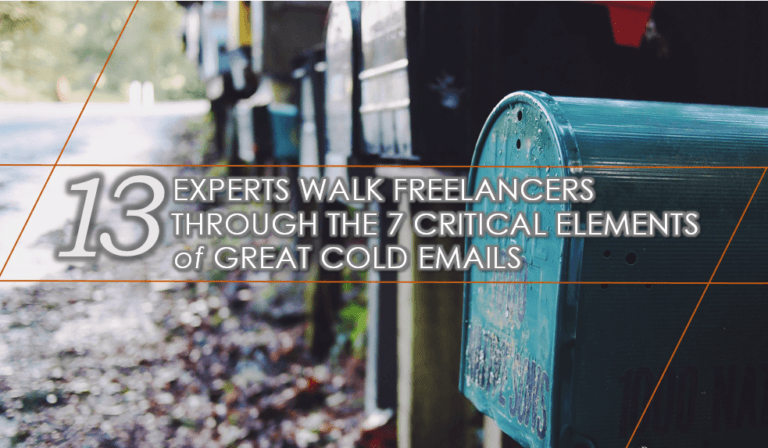When it comes down to it, freelancing is tough.
Especially for anyone new to the freelancing world.
Not only do you have to market yourself, you need to find enough time to do what you’re actually good at…the work.
As a freelancer, you dream of having all the freedom and time to work as you please.
No more 9-5. No more cubicle. Just the work you enjoy, when you want, and how you want.
But the truth is, it just isn’t as simple as that.
The downside to freelancing? The inconsistency of it all.
Unless you hit the goldmine with a long-term client who pays monthly, you can never really be sure when the next paycheck will come.
How many times have you agreed to do work well below your pay scale just to keep money coming in?
It doesn’t have to be like that, though. Part of it comes down to your pricing strategy. It says a lot about you as a freelancer.
In this post, we’re going to explain exactly what your freelance pricing strategy says about you and how you can improve it to get better rates, better clients, and a better quality of freelance life.
Why your pricing matters?
In simple terms, price too low and you won’t have enough money to run your freelance business and you’ll be lumbered with bad clients.
Price too high, and you might struggle to get clients in the first place.
Pricing is important. One of the most important things a freelancer should worry about, other than doing good work.
Because, the difference between getting your pricing right or wrong is either having to go back to full-time work 9-5 or being able to live the life that you choose.
As a freelancer, you’ve probably sat down at some point and questioned the following:
I can’t outprice my competition, I’ll get no work.
All my clients will leave me.
How will I earn money?
This all comes down to fear, though. Fear that you won’t get any work charging higher rates so you settle to work with low-paying clients who often demand more from you.
Pricing too low
When you price too low. A few things happen.
First of all, you have to do more work to get enough money to survive.
Secondly, you have to hunt out clients who don’t value your work and are happy to pay the lowest rates. In most cases, these clients aren’t worth your time.
What that says about you as a freelancer:
Firstly, you don’t have much experience and/or are not talented. If you’re a completely new freelancer, you might not have the experience or previous clients to use as a testimonial, so you’ll have to charge low.However, some clients perceive low paying freelancers as untalented..
Secondly, it suggests you don’t plan to spend much time doing the work. Some clients might believe if you’re charging so little to do the work, you won’t spend much time on it.
Pricing too high
First of all.
Don’t be afraid of charging too much. Your pricing tells a story.
It tells the story of who you are as a person and how you position yourself as a freelancer.
Think about designer t-shirts.
You can buy a plain black t-shirt for $400
Or you can buy a plain black t-shirt for $4.
Now, to the naked eye, people probably won’t be able to tell the difference between these two t-shirts, but why do some people buy them for $400, if they can get the same thing for $4?
Mostly because of the perceived quality they believe they’re getting.
They’re looking to buy a name, not just a t-shirt. They’re buying their place in a brand they believe to be prestigious.
This is the same for freelancers. Often, if you have a high price, clients will assume you have all the skills, experience, and know-how to get their job done.
But you also have people who charge too much, for too little work. Don’t be this person.
In this situation, we’re talking about the ‘web designers’ who charge a huge premium to download an already pre-made WordPress theme.
And when clients look at your portfolio they see a number of different websites, all with similar themes.What does that say about you?
Well, first of all, it says you’re cocky. You believe yourself to be better than you actually are.
Secondly, it says you’re inexperienced. If you’re just rehashing old WordPress themes for a premium, surely you don’t actually have the skills required to create something bespoke and new.
Obviously, you don’t want to charge too much and price yourself out the market.
Let’s pretend, for example, it’s a simple HTML code change. If someone can do it for $50 and you’re charging $500 they’re going to go with the $50.
Finding the sweet spot
A lot of freelancers spend a great deal of time trying to find their sweet spot…the amount of money they need to break even.
This includes accounting for any materials you need too. But remember, the time you’re spending looking for clients is work you’re not billing for.
But once you’ve found the sweet spot, the aim is to raise prices enough to have a healthy profit.
Finding the sweet spot is a combination of working with the right clients and providing enough value to those clients so they have no qualms with paying you your chosen rates.
Think about it like this.
If you want to charge your clients $5000 a month for SEO services, then you need to ensure you’re providing $5000 a month worth of value.
So if a lead is worth $10,000/month to that client. And you promise them, with your SEO skills, you’ll bring in a minimum of three leads per month.
They’re getting $30,000/month value, so why wouldn’t they be happy to pay you $5000?
Be flexible. Some clients will prefer hourly billing and some will prefer day rates or retainers.
In the beginning it’s important to understand your pricing strategy won’t suit everyone. But it’s wise to charge higher first, provide enough value and be prepared to be knocked down later on.
New to the game freelancers
What if you’re new to the game? You don’t have any previous clients to provide epic references, and you don’t have experience in the freelancing business you’ve just entered?
How do you raise your prices?
Jumping straight to premium pricing could hinder your efforts.
Why?
Because when you’re just starting out, what matters more to you than money should be ‘experience’. As I’ve mentioned, freelancing is tough. There are a lot of clients to pick from, a lot of work to take on.
The more clients you can work with early on, will give you a better understanding of how to deal with clients.
This way, you’ll be more prepared to start to working with higher paying clients.
When you’re just starting out, the main thing you need is clients through the door, and a low pricing strategy will do this.
Yes, you’ll have to deal with annoying clients, and clients who don’t pay on time, and clients who make you do more work than you need to but from it, you’ll gain that invaluable experience I was talking about.
Providing Value
You need to own and know your worth. If you don’t value yourself, no one else will.
What problem do your potential clients have and how can you offer your services as a solution?
If you’re a designer for example. Don’t just say you can create cool graphics. No one needs that, not really.
But imagine if you repositioned yourself, and told your clients and future clients the graphics you make will keep prospects on their website for longer, and the longer they stay on your website, the more likely prospects are to convert.
Here you’re having actual tangible value. You are creating results.
One solution people have found, is to create a result-driven pricing strategy. The clients pays you a minimum for the base-work. Then there is an added fee for results.
This works great for two reasons:
- The client only pays a base minimum. Their risk is reduced
- You can be paid LOADS.
Imagine you charged a client $500 and it brought them $50,000 in revenue…wouldn’t you want to be charged more for that work?
But the issue with this pricing strategy is, you need to be completely confident in your abilities to actually achieve the results you say you can achieve.
Takeaways
Freelancing pricing strategies are tough.
But you’re only the only one going through this.
You need to break down your pricing strategy into the cost and the price. They’re different. One (cost) is about the amount of money you need to run your business and survive and the other (pricing) is about the value you provide.
It’s why you’ve got freelance writers on Upwork writing 2000 words for $20 and some writers who charge $500 for the same work.
In another post, we’ll look at exactly how you raise your prices and how you address this with your clients.
Think about what you want from your freelance lifestyle and find a way to rid yourself from the bad clients.
Your pricing strategy comes into your branding as well. So it really is something you need to think about.
Pricing is about how your potential client perceives your talent.
We can’t write a blog post telling you what to charge simply because we don’t know the kind of clients you’re going for and we don’t know the kind of work you’re doing.
Once you become a master of your field, you can start charging whatever you please.
Once you know you can provide exceptional value for every client who walks through the door, you’ll be able to turn away the ones who don’t fit your standards.
You’ll spend less time hustling for clients and more time doing the actual work you love.
Your freelance pricing strategy says a lot about you.
Make sure it says the greatest story.
Want more like this?
Check out our How-To Case Study video training and learn how to attract premium clients, how to price your services, and how to automate your client getting process.





